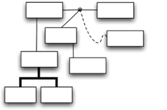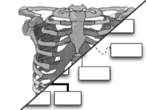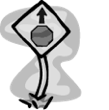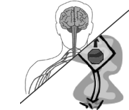Business Rules: The Body Analogy
In many ways, rules are the most important component since they provide control for the other two. The business and its systems are certainly capable of behavior without a well-organized set of rules — but not effective, adaptive behavior. Literally, rules are what make a business more than half-smart in how it operates. This month's Reprise for Rules uses an analogy to the human body to illustrate.
From Business Rule Concepts: Getting to the Point of Knowledge (4th Edition), by Ronald G. Ross, 2013.
https://www.brsolutions.com/publications/business-rule-concepts/
The human body is marvelous in many respects, not the least of which is its mechanics. Roughly, support for the mechanics of the human body has three basic components, separate yet intimately interconnected, as follows.

Structure is provided by the bones, which are organized and connected within the skeleton. The skeleton provides both a framework for carrying the weight of the other components as well as a semi-rigid scheme around which the other, softer components can be organized.
Power is provided through the muscles, which are connected to the bones. The muscles enable motion based on the framework provided by the skeleton. Since motion is what we see happening from outside the body, the muscles seem most directly responsible for the behavior we perceive.
Control is provided by the nervous system, which connects to the muscles. Nerves indirectly connect muscles to other muscles through long series of connections passing through the brain. Responses to all stimuli are coordinated through the firing of nerve impulses — no firing, no movement, and therefore no behavior.
These basic mechanical components are familiar to us all. In a moment, we will see how the mechanics of business operations should be viewed in the very same way. As we examine the analogy, several observations about the mechanics of the human body are worth keeping in mind.
- All three components are essential. The human body literally cannot function without all three.
- The three components are all interconnected — that is, they are integrated with each other. For example, tendons connect muscle to bone. Successful behavior depends on this integration.
- Each of the three components is specialized for a particular role or responsibility. Each optimizes for its particular task. Mixing or combining the three components would provide a much less effective solution. Also, specialization provides for greater simplicity. Think about how much more complex bones would be if they incorporated muscles or how much more complex muscles would be if they incorporated nerves.
- The nervous system in some sense is the most important component because it provides coordination and control for the other two. The body is certainly capable of behavior without a well-organized nervous system — but not effective, adaptive behavior. Literally, you cannot operate at your best with only half a brain!
The Organization of Business Operations
We believe that business operations should be organized in a manner similar to the mechanical system of the human body. Let's revisit the three components of that system, thinking now about business operations in place of the human body.
 Structure
Structure
Structure is provided by organized — that is, structured — knowledge about basic things in the operational part of the business. Generally, this knowledge or know-how consists of two kinds:
- Everyday noun concepts — things we refer to with nouns.
- Everyday connections we make between those noun concepts — things we often say using verbs.
These 'basic things we can know' are often simply taken for granted — just like the human skeleton in everyday activity.
Think of the noun concepts as bones and the verb connections between them as ligaments (that is, bone-to-bone connections).
- Just as each bone has a particular shape that is optimal for its purpose and location, so too must each noun concept have a carefully-crafted 'shape'. A concept's shape is given by its definition, which must be clear, concise, and well-suited for its business purpose.
- Every bone or noun concept should also have a standard name. The standard name for a noun concept is a term.
- Each ligament also has a particular shape that is optimal for its purpose and location. Similarly, each verb connection between noun concepts must also have a standard 'shape'. These shapes are expressed by wordings that reference the relevant terms.
Definitions, terms, and wordings are all about meaning, the stuff of business vocabularies. Business vocabularies represent what we know about the operational business and how we can talk about it in an organized fashion. (From this point on I may drop the modifier "business" for "vocabulary", but I always mean business vocabulary.)
These days, discussion of vocabularies often falls under the heading semantics. However, when I discuss semantics, I seldom use that term. It sounds arcane. I will generally just say meaning whenever the opportunity arises. There is really nothing arcane about the vocabulary of day-to-day business operations — no need for buzzwords or technical hype, just a lot of common sense.
A drawing or diagram of the complete human skeleton helps us understand how all the bones fit together. To illustrate overall vocabulary structure for a business at the operational level, it is likewise helpful to create a drawing or diagram. We call such a drawing a graphical concept model.
 A concept model provides a framework, in many ways like a skeleton, in two basic respects.
A concept model provides a framework, in many ways like a skeleton, in two basic respects.
- A concept model literally provides a structure around which the other components can be organized — that is, the 'basic things we can know' in common about the business at the operational level.
- A concept model bears the 'weight' of the organization — that is, its collective or shared know-how, as put to use by its processes and business rules.
 Power
Power
Power is provided by processes, which operate on the structure. Whereas the concept model provides for structure, the processes provide for activity.
 When we think about a business, its processes are often the first things that come to mind. Processes literally do what the business needs to get done (e.g., take the customer's order). However, viewing business operations as merely a collection of processes makes no more sense than viewing the human body as merely a collection of muscles. Any organism is much more than that — whether human or business.
When we think about a business, its processes are often the first things that come to mind. Processes literally do what the business needs to get done (e.g., take the customer's order). However, viewing business operations as merely a collection of processes makes no more sense than viewing the human body as merely a collection of muscles. Any organism is much more than that — whether human or business.
 Control
Control
Control is provided by business rules, which constrain processes (the 'muscles') to act only in certain ways deemed best for the business as a whole. In the human body, there are literally hundreds of muscles, which must act in concert. If they do not, the resulting behavior won't be optimal. At worst, serious damage can result (e.g., hyperextension of a limb) that will significantly reduce the body's overall capacity to act.
 Similarly, business operations encompass dozens (or hundreds) of 'muscles' (processes), which must act in concert. If they do not, the resulting behavior won't be optimal either. In some cases, serious damage can result (e.g., loss of customers, squandering of resources or opportunities, and so on) that will significantly reduce the business's overall capacity to act (that is, its competitiveness or effectiveness).
Similarly, business operations encompass dozens (or hundreds) of 'muscles' (processes), which must act in concert. If they do not, the resulting behavior won't be optimal either. In some cases, serious damage can result (e.g., loss of customers, squandering of resources or opportunities, and so on) that will significantly reduce the business's overall capacity to act (that is, its competitiveness or effectiveness).
In the human body, we take many control actions of the nervous system for granted. For example, who thinks about the impulses sent to the heart to make it beat — unless, of course, something goes wrong? Or who in saying "Ouch!" thinks much about the jerk reflex that causes the hand to move so quickly off the hot stove? So long as all runs smoothly, we can apply our mental faculties to a higher purpose — whether for strategic or tactical advantage, solving a problem, or simply planning a fun lunchtime getaway.
Similarly, while operations run smoothly in the business, we can take the control provided by the business rules for granted and concentrate on matters requiring a higher degree of intelligence. Until a business rule 'breaks' somehow — and that is a very important possibility, of course — we can focus on the more creative aspects of the business.
Summary
A business is very much like a human body — a living organism.
- Structure, the skeleton, is provided by basic noun concepts as represented by terms, and verb connections between those noun concepts as represented by wordings.
- Power, the muscles, is provided by processes.
- Control and coordination, the nerves, are provided by business rules.
Let's revisit the observations I made earlier about the mechanics of the human body, now applying them to business operations.
- All three components — concept model, processes, and business rules — are essential. A business literally falls apart, disintegrates, without all three.
- The three components are obviously interrelated. For example, the processes act on knowledge about things represented in the concept model. These actions, in turn, are subject to the business rules. Successful business behavior depends on effective integration. These fundamental interrelationships must obviously be taken into account.
- Each of the three components is specialized for a particular role or responsibility and optimized for its particular task. Mixing or combining them would provide a less effective solution. Therefore, the business rules need to be factored into a separate rulebook (automated, of course). We call this separation Rule Independence. As a fringe benefit comes a huge simplification in the processes. Indeed, now it is legitimate for the first time to talk of truly thin processes — a long-standing goal among many information technology (IT) professionals.
- In many ways business rules are the most important component since they provide control for the other two. The business and its systems are certainly capable of behavior without a well-organized set of business rules — but not effective, adaptive behavior. Literally, business rules are what make a business more than half-smart in how it operates.
Glossary
business rule: [SBVR] a rule that is under business jurisdiction
business vocabulary: the set of terms and their definitions, and all wordings, that organize operational business know-how
concept model: the semantic blueprint of a business vocabulary
definition: [MWUD] 2: a word or phrase expressing the essential nature of a person or thing or class of persons or of things : an answer to the question "what is x?" or "what is an x?"
know-how: [MWUD] … accumulated practical skill or expertness … especially: technical knowledge, ability, skill, or expertness of this sort
noun concept: the concept that a term represents
Rule Independence: the externalization, unification, and management of rules separately from processes
rulebook: the collection of elements of guidance for a business, along with the statements, terms, definitions, and wordings that support them
semantic(s): [MWUD (noun) — semantics]: a system or theory of meaning [MWUD (adjective) — semantic]: of or relating to meaning in language
term: [MWUD] 8a: a word or expression that has a precisely-limited meaning in some uses or is peculiar to a science, art, profession, trade, or special subject
wording: an expression including one or more terms and a verb or verb phrase, organized appropriately to represent a verb concept (e.g., 'customer places order')
Reference Sources [MWUD] Merriam-Webster Unabridged Dictionary (Version 2.5). [2000]. Merriam-Webster Inc. [SBVR] Semantics of Business Vocabulary and Business Rules (SBVR). [Dec. 2019]. Object Management Group. |
# # #
About our Contributor:
Online Interactive Training Series
In response to a great many requests, Business Rule Solutions now offers at-a-distance learning options. No travel, no backlogs, no hassles. Same great instructors, but with schedules, content and pricing designed to meet the special needs of busy professionals.











